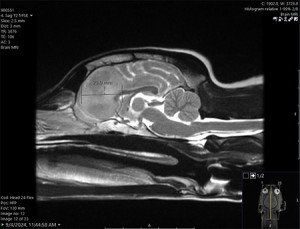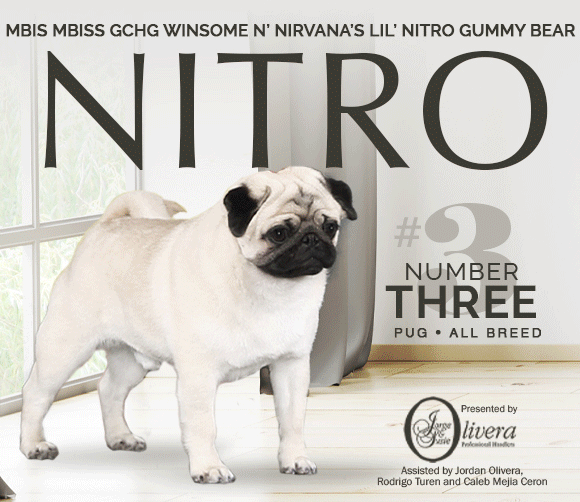One Tiny Dog’s Outsized Contribution to Brain Surgery
From: University of Pennsylvania School of Veterinary Medicine
Geddy has lived a big life for a little dog. As a puppy, the tiny terrier mix was abandoned in Mississippi during a high-speed car chase. Rescued by law enforcement, she found a loving home in Pennsylvania. Life was good — until last summer.
In August, Geddy began having seizures, and her veterinarian referred the eight-year-old to Penn Vet for further evaluation. At Penn Vet’s Ryan Hospital, Tessa Arendt, DVM, specialty intern in Neurology, and Wojciech Panek, DVM, DACVIM, assistant professor of neurology and neurosurgery in the Department of Clinical Sciences and Advanced Medicine, performed a brain MRI, which revealed a right frontal lobe mass.
“An MRI doesn’t always tell us exactly what we’re dealing with even though it allows us to see the tumor,” said Panek. “Based on Geddy’s tumor imaging characteristics, we suspected a glioma — an aggressive brain tumor.”
Gliomas affect both dogs and humans. In people, the most malignant type, glioblastoma, carries a life expectancy of approximately 15-18 months with surgery, radiation, and chemotherapy. Without aggressive treatment, dogs typically survive for about a few months. Geddy’s owner wanted every option explored, including surgery. Surgery would also enable Panek to biopsy the tumor for a more exact diagnosis and to guide further therapeutic opportunities for Geddy.
Little Brain, Big Impact
Geddy’s procedure took place in September. She arrived at Ryan Hospital on a Monday. A week later, she would leave as a pioneer—the first dog to undergo successful brain surgery using cutting-edge augmented reality technology combined with infrared real-time guided resection.
Her case required a highly specialized team, including a veterinary neurosurgeon, radiologist, anesthesiologist, pathologist, nurses, and operating room technicians.
Joining the Penn Vet experts was a renowned neurosurgeon and brain tumor specialist from Penn’s Perelman School of Medicine: Presidential Associate Professor of Neurosurgery Nduka Amankulor, MD, chief of neurosurgical oncology, and director of the Penn Brain Tumor Center.
Amankulor and Panek partnered on Geddy’s case, merging world-class expertise in human and canine neurosurgery to push the boundaries of veterinary and human medicine.
“When I started at Penn, I approached Nduka because we face similar challenges,” said Panek, who has shadowed his colleague in human surgeries. “What’s fascinating is that dogs develop gliomas nearly identical to those in humans. The immune landscape is similar, and the prognosis is nearly the same. That makes cases like Geddy’s incredibly valuable for both veterinary and human science to advance the care mutually.”
A Three-Pronged, Groundbreaking Approach
The primary goal of cancer excision—or debulking—surgery is to achieve “clean margins.” Even the tiniest remnant of cancerous tissue can increase the risk of local recurrence and disease spread, but gliomas infiltrate healthy brain tissue, making it extremely difficult to distinguish the tumor border.
Geddy’s care team used a combination of advanced tools to ensure precise debulking.
“We combined several novel techniques to achieve the best possible tumor resection,” said Panek. “This was a unique three-part approach.”
A day before surgery, the pup received an injection of a special dye that glows under near-infrared light and accumulates in cancer cells. The imaging agent helps neurosurgeons better identify the limits of the glioma. Penn Vet’s David Holt, BVSc, professor of surgery, developed this technique to remove mammary and lung tumors from dogs.
The next day, Geddy was placed under general anesthesia. The team performed a modified trans-frontal craniotomy, opening her skull for access to the brain. They then used three critical tools for guidance.
Breaking new ground, the surgical team employed an augmented reality neuro-navigational system to obtain optimal access to the tumor.
“The technology created a hologram from Geddy’s initial MRI, which was really helpful for procedure planning and for navigating hard-to-see areas,” said Panek. By superimposing Geddy’s MRI images with anatomical accuracy onto Geddy’s skull, the surgeons were able to first biopsy and then debulk the tumor.
Novarad Corporation developed the VisAR technology, and company representative Darin Johnson assisted in calibrating it during surgery.
Next was the infrared imaging: “We shined an infrared camera on the brain, picking up the dye to map the tumor as we operated,” said Panek.
“Because infrared imaging is still relatively new, we also integrated intraoperative ultrasound,” he said. “This enabled us to see into the brain in real-time and confirm the infrared imaging was accurate and that we were removing the tumor to best of our ability.”
The complex and delicate procedure took about five hours and was a success. Geddy emerged from surgery, unaware she had just made history.
Remarkable Dog, Remarkable Recovery
The following day, Geddy was awake and charming her care team. Soon after, they discharged her with medication to manage inflammation and prevent seizures. A follow-up a few weeks later showed she was healing well, and a November MRI indicated no radiological signs of tumor regrowth.
Geddy will be re-evaluated at Ryan Hospital in March, and Panek and Amankulor hope to have the final genetic testing results then.
“In human medicine, we often have clearer answers because of extensive research and data. But in veterinary medicine, we are still building our knowledge. Cases like Geddy’s help validate our approach and provide insights for future studies in dogs and humans,” said Panek.
For now, Geddy exemplifies what’s possible when human and veterinary medicine unite to offer hope and healing for pets and people alike.
Short URL: https://caninechronicle.com/?p=319613
Comments are closed













